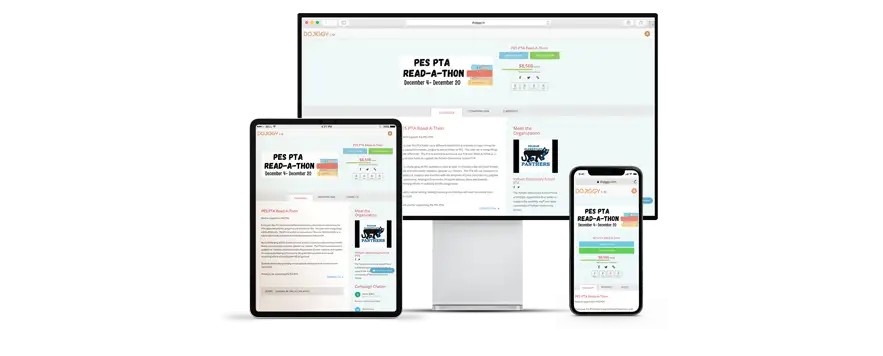The Best Fundraising Strategies for Nonprofits to Raise More
Many Nonprofits Are Looking for New, Virtual Fundraising Strategies During COVID-19
From Text to Donate to Live Streamed and Virtual Events, We Have You Covered
Discover the importance of fundraising strategies for nonprofits! When it comes to fundraising, a comprehensive strategy is essential for the success of any nonprofit organization. Before launching a fundraising campaign, it is vital to establish measurable goals and implement a reliable tracking system. By having a well-defined vision and specific objectives, your organization increases the likelihood of achieving them. Many experienced fundraising professionals recommend starting with an impact-focused goal when crafting a fundraising vision or strategy.
 Consider this example: Your organization aspires to clean up a local park; this is the desired community impact. To achieve this goal, you can determine the amount of money required to accomplish it. This approach facilitates effective communication with supporters. By clearly illustrating your organization’s mission and demonstrating how their donations contribute to its fulfillment, you foster donor trust and transparency. These elements are crucial for ensuring consistent and secure funding.
Consider this example: Your organization aspires to clean up a local park; this is the desired community impact. To achieve this goal, you can determine the amount of money required to accomplish it. This approach facilitates effective communication with supporters. By clearly illustrating your organization’s mission and demonstrating how their donations contribute to its fulfillment, you foster donor trust and transparency. These elements are crucial for ensuring consistent and secure funding.
So read on to discover the best fundraising strategies for your charity organization.
Why Do People Give to Nonprofit Organizations?
Once you have established your vision, it’s time to develop a comprehensive fundraising strategy for your nonprofit. Avoid relying on a single funding source; aim to diversify your funding streams. Doing so minimizes risks and enhances the likelihood of securing the necessary funds. Consider organizing multiple fundraising campaigns to further diversify your support base. This approach enables donors and prospects to contribute throughout the year and allows you to raise greater awareness for your mission.
In general, there are three groups that your organization can look to for funding. These include:
Individuals
Businesses
Foundations
These groups give to organizations for various reasons. You will want to discover who your current constituents are and why they support your organization. Then, think about new supporters from the groups below.
- A personal connection to the cause – Health organizations, schools, and churches benefit here. If someone has a family member affected by breast cancer, they are much more likely to engage in breast cancer fundraising initiatives. Your children’s school or your Alma mater is likely high on your list, as well.
- Desire to give back – Many people have the altruistic desire to do good. They seek out opportunities and passions where they feel that they can make the most impact. Tell them stories about your organization and how their donations will affect people or animals and they will want to give.
- Recognition for giving – Businesses, foundations, and larger donors seek recognition for their donations and sponsorships. Provide sponsorship tiers and monthly giving campaigns that offer incentives to reach these donors.
- Tax incentives – Year-end giving is largely motivated by tax incentives. Don’t miss out on this opportunity – run annual appeals and provide timely donation receipts to all donors.
- Donating to a friend – Peer-to-peer fundraising campaigns have become very popular. Why? Organizations are tapping into this social need for people to support friends and family members’ support of a cause.
Seven Winning Nonprofit Fundraising Strategies
Motivating Donors
While it might sound like nonprofit fundraising is all about the money, it’s about so much more. Money is a tool for your organization to accomplish its mission. One of the basic principles for fundraising is to see beyond just money and instead to see it as a means to an end.
Instead of just asking your donors for money, educate your donors as to how their donation makes an impact. Inspire them to join you as a partner in accomplishing this mission. This helps you show them what their donation means and, more importantly, what it accomplishes.
While raising funds is always important, organizations often have other needs. For example, volunteer labor might be needed to help organize an event. A key to successful nonprofit fundraising strategies is to identify your organization’s needs and develop programs that help to fill these needs. Give donors a chance to assist your organization in ways outside of donations. This could be volunteering at events or donating supplies or other in-kind contributions.

Peer-to-peer and nonprofit crowdfunding campaigns offer a great way of inspiring your supporters to engage with your organization. When individuals choose to raise money for a nonprofit by utilizing their contacts, their network can span far and wide, especially geographically. Peer-to-peer fundraising has all the magical elements of a perfect ask for support. It highlights a worthy mission, a story is told, and there is passion from the person telling the story and the one-on-one connection that makes the ask to support a nonprofit even easier, coupled with a case for support that is strong and compelling.
Motivating higher-level donors like corporations is also important. Getting a company or corporation to give to a nonprofit is about learning and understanding their needs. Will giving to your organization assist its marketing efforts? Will a partnership with you increase overall revenue or improve the brand image? Learning the specifics of what a corporation is looking to gain will go a long way to bringing them on as a donor or corporate sponsor. Furthermore, just like with traditional donors, educating them on the true impact of their donations can also go a long way. Businesses can also encourage employees and customers to donate personally, further building your donor base.
Determining the Best Nonprofit Fundraising Strategies for Your Organization
Successful fundraising strategies vary by organization. Keep the following considerations in mind when building your nonprofit fundraising strategies:
- What is your fundraising budget? This is an important question to ask. If you have a small up-front budget, a large fundraising event such as a gala is probably not the answer. This type of fundraiser requires initial investment (securing a venue, paying for permits, paying for marketing/promotional expenses, catering down payments, and more). Prepare a detailed fundraising event budget before you embark on a large-scale fundraiser. Remember, your goal is to raise money, not spend more than your organization can afford.
- How big is your team of supporters? If you have a number of participants that can help you raise funds, a peer-to-peer fundraising event such as a walk-a-thon fundraiser might be a perfect choice. Here each participant can help raise funds by creating a personal fundraising page they can share throughout their personal and social networks. Whereas a small team of people planning the fundraiser may lend itself to something less labor-intensive such as a fundraising raffle.
- What about your database? Perhaps you don’t have a lot of volunteers to help out at a fundraising event, but if you have a huge database of previous donors and potential supporters. Maybe an online donation drive is the right answer for your organization. You can easily send an email message to your database inviting them to click on your donations website and make an online donation. It makes it easy for donors to give back without having to obligate much time or energy by attending an event.
- How can you leverage your resources? Perhaps you have a strong board of directors or a large volunteer and donor group? On the other hand, you might be a small nonprofit with only a few very dedicated supporters. Regardless, tap into those who support you and see how they can help. Not just by donating, what else can they do? Can their business match their donation? Can they host a small coffee group to introduce your organization to their friends and neighbors? Can board members send fundraising notes to their contacts? Can individuals post announcements on their social media channels?
- Who can take on a leadership role? It is impossible for one person to do it all. If you are a nonprofit with a small development staff, see if you can delegate some roles to trusted supporters or friends. Perhaps there are people with connections to large organizations who can help with sponsorship proposals. Or maybe someone is interested in taking the lead for finding and scheduling volunteers. You’d be amazed to find out how many people may be willing to lend a hand…especially if they are passionate about your cause. This strategy is a must for school and PTO fundraising initiatives.
- How much time do you have? Is it Q4, and you’ve realized you are 20% shy of your annual goals? If so, you need to do something quick! With little lead time, you’ll likely be looking at more of an online fundraising initiative that could possibly be spread with the help of all of your networks. You have little time to facilitate planning a fundraising event or securing in-kind donations or prizes for a raffle or auction, but it doesn’t take long to get a fundraising website up and promote your online fundraising campaign via social networking. Giving Tuesday is a great time to launch this type of year-end fundraising appeal.
- Is your fundraiser scalable? If you find a fundraiser that works, why reinvent the wheel? Try to find a successful fundraiser that can be planned once and then used repeatedly. This will help you save valuable time and resources and provide an expectation for your supporters. As time goes on, people may end up coming to you to offer their time and support rather than you seeking their help. Business sponsors and donors may end up budgeting for your fundraiser well in advance if it’s something they can plan on year after year. Charity golf tournaments make great signature events.
- Fish from multiple pools – Some organizations only focus on major gifts from big donors. They figure that if they can get thousands from one donor or business, it isn’t worth focusing on the groups bringing in smaller funds. Others have a contrary view, thinking they will do better with smaller, more frequent donations and don’t waste their time selling big pitches. The best plan is usually to try both! Never limit your reach. You have no idea where one small donor supporter can lead you (perhaps they have a connection to one of those big fish that will come on board later). Similarly, not targeting businesses or large donors could result in missing out on a great opportunity.
- What tools do you have to accomplish your goals? This is an important question. How do you intend to execute your fundraiser? Our fundraising software for nonprofits can be extremely helpful, especially if you are low on resources. The easy-to-use tools take much of the legwork off your administrators while simplifying the process for your constituents. Participants can easily register for events, donors simply click a button to make an online donation, event details are seamlessly updated and shared via a fundraising website, and communications are automatically pushed out to your supporters. In addition, numerous reports can be generated to help track progress, manage databases, and evaluate your campaign’s success.
DoJiggy Helps Nonprofits Implement Successful Fundraising Strategies at Affordable Prices

Maintaining a Consistent Image and Brand
 It’s important for your nonprofit’s brand, identity, and image to be very clear and consistent across all marketing channels. Yes, that’s right – your nonprofit has a brand and image, even if you didn’t know it. Your image on your organization’s website, fundraising websites, emails, social media, and print should all be consistent. This helps inspire confidence in your donors and prospects while helping to build your credibility.
It’s important for your nonprofit’s brand, identity, and image to be very clear and consistent across all marketing channels. Yes, that’s right – your nonprofit has a brand and image, even if you didn’t know it. Your image on your organization’s website, fundraising websites, emails, social media, and print should all be consistent. This helps inspire confidence in your donors and prospects while helping to build your credibility.
Donors want to feel confident in you and what you represent. When images are misaligned, donors can become confused – especially online. Ensure that all your logos are updated and correct across your web properties. It’s also important for logos and other graphics to fit correctly, be of the proper resolution, and not be cut off. You wouldn’t advertise on a billboard on a busy highway with a misaligned logo. Similarly, check your social media and website properties to ensure that all images and logos lend credibility and consistency to your organization’s image.
This allows your donors to consistently see you in multiple places as they may research your nonprofit organization and mission. This credibility helps convert prospects into donors and inspires confidence while encouraging long-term donors.
Read more on creating your nonprofit brand.
Sustaining Regular Donor Communications

Regular, clear communication with your donors is another critical basic strategy. Fortunately, today’s technological advancements make communication more accessible than just 10 years ago. Email, social media, blogs, and other channels are available, allowing you to easily communicate directly with your donor base. It also allows you to have a direct conversation, answer questions, and be more engaged publicly with your supporters.
The key here is to be regular with your communication and do so via every channel you have available. Posting regularly on social media shows you have a presence and are active, while regular emails keep people informed.
When it comes to fundraising, let donors know of your progress regularly. Afterward, thank them for their contribution, and educate them as to how their funds were used, and the changes that were made as a result. Donors don’t just donate to fulfill your needs; they donate to fill their needs as well. Showing that they made a difference in the world or your organization goes a long way to retaining donors over a longer period.
Hosting Great Nonprofit Fundraising Events

One of the most challenging aspects of nonprofit fundraising can be developing and implementing creative event ideas to engage and excite participants. You need to consider your audience and your available fundraising event budget and resources before deciding on a fundraising event. The best events are hosted year after year and can become your organization’s signature events, looked forward to well in advance.
There are many ideas out there, but we’ve compiled some of the best and a few of our favorites. From walk-a-thons to wine tastings, these nonprofit fundraising ideas can help you make your next fundraising campaign a huge success.
Benefits of Online Fundraising Strategies

You may have noticed that all of these nonprofit fundraising strategies involve an online component. While you may be hosting a walk-a-thon at a local park, your event registration and fundraising will occur online on your peer to peer crowdfunding platform. So why are online fundraising and utilizing fundraising software tools such an important fundraising strategy for nonprofits to embrace?
Online Fundraising Extends Your Organization’s Reach
A primary benefit of online fundraising is the ability to extend your reach beyond your community. Fundraising used to be about walking door-to-door and asking neighbors to make donations or making personal phone calls to family and friends. With online fundraising, your network expands globally. As well, your constituents can easily engage in fundraising efforts by sending donation requests via email or posting links from their social networks or sharing videos on YouTube. All of these things help drive potential donors to your organization’s fundraising website. By asking people to forward your request to their social network, your reach grows exponentially.
Nonprofit Fundraising Websites Offer a One-Stop Fundraising Hub
By implementing an online fundraising campaign, you create a fundraising website that becomes the central hub for your fundraiser. Here’s the place where you direct potential donors to learn more about your cause and make online donations. This is where all information is shared and data is stored. Your fundraising website can be accessed anytime from a laptop, mobile phone, or tablet.
Online Fundraising Simplifies Fundraising Strategies and Transactions
Online fundraising simplifies all transactions. Participants are easily able to register online, purchase tickets, join teams, and more (rather than mailing in checks and registration forms). Online fundraising also allows for secure online payment processing via credit card. After transactions are made, our software tools track payments, manage recurring donations, and generate various financial reports. Participants can easily track progress as donations are tracked in real time. Every time a contribution is made, fundraisers can track this against goals. Administrators can also generate numerous financial and participant reports in the administration area.
